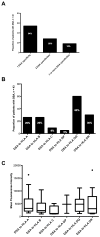Human leukocyte antigens antibodies after lung transplantation: Primary results of the HALT study
- PMID: 29687961
- PMCID: PMC6117197
- DOI: 10.1111/ajt.14893
Human leukocyte antigens antibodies after lung transplantation: Primary results of the HALT study
Abstract
Donor-specific antibodies (DSA) to mismatched human leukocyte antigens (HLA) are associated with worse outcomes after lung transplantation. To determine the incidence and characteristics of DSA early after lung transplantation, we conducted a prospective multicenter observational study that used standardized treatment and testing protocols. Among 119 transplant recipients, 43 (36%) developed DSA: 6 (14%) developed DSA only to class I HLA, 23 (53%) developed DSA only to class II HLA, and 14 (33%) developed DSA to both class I and class II HLA. The median DSA mean fluorescence intensity (MFI) was 3197. We identified a significant association between the Lung Allocation Score and the development of DSA (HR = 1.02, 95% CI: 1.001-1.03, P = .047) and a significant association between DSA with an MFI ≥ 3000 and acute cellular rejection (ACR) grade ≥ A2 (HR = 2.11, 95% CI: 1.04-4.27, P = .039). However, we did not detect an association between DSA and survival. We conclude that DSA occur frequently early after lung transplantation, and most target class II HLA. DSA with an MFI ≥ 3000 have a significant association with ACR. Extended follow-up is necessary to determine the impact of DSA on other important outcomes.
Keywords: clinical research/practice; histocompatibility; lung transplantation/pulmonology; major histocompatibility complex (MHC); monitoring: immune; rejection: T cell mediated (TCMR); rejection: antibody-mediated (ABMR).
© 2018 The American Society of Transplantation and the American Society of Transplant Surgeons.
Conflict of interest statement
The authors have no conflicts of interest to disclose as described by the American Journal of Transplantation.
Figures



References
-
- Charman SC, Sharples LD, McNeil KD, Wallwork J. Assessment of survival benefit after lung transplantation by patient diagnosis. J Heart Lung Transplant. 2002;21:226–232. - PubMed
-
- De Meester J, Smits JM, Persijn GG, Haverich A. Listing for lung transplantation: Life expectancy and transplant effect, stratified by type of end-stage lung disease, the Eurotransplant experience. J Heart Lung Transplant. 2001;20:518–524. - PubMed
-
- Hosenpud JD, Bennett LE, Keck BM, Edwards EB, Novick RJ. Effect of diagnosis on survival benefit of lung transplantation for end-stage lung disease. Lancet. 1998;351:24–27. - PubMed
-
- Singer LG, Chowdhury NA, Faughnan ME, et al. Effects of recipient age and diagnosis on health-related quality of life benefit of lung transplantation. Am J Respir Crit Care Med. 2015;192:965–973. - PubMed
Publication types
MeSH terms
Substances
Grants and funding
LinkOut - more resources
Full Text Sources
Other Literature Sources
Medical
Research Materials

